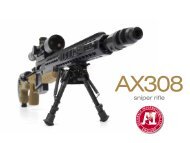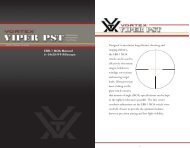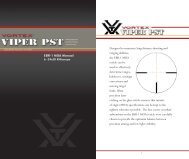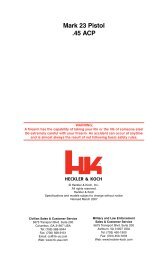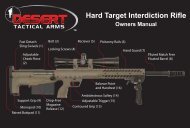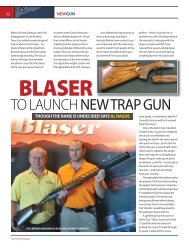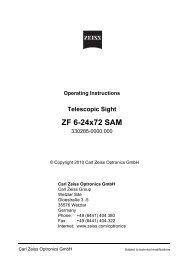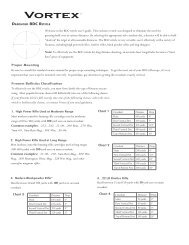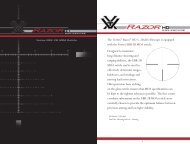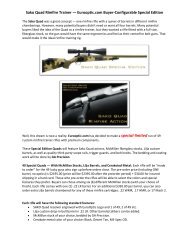Tactical Riflescope User's Manual - Leupold
Tactical Riflescope User's Manual - Leupold
Tactical Riflescope User's Manual - Leupold
You also want an ePaper? Increase the reach of your titles
YUMPU automatically turns print PDFs into web optimized ePapers that Google loves.
Table of ContentsKnow Your Scope .............................................. Page 2How to Install the Scope ........................................ Page 4How to Sight-In ............................................... Page 8Making Precise Windage And Elevation Adjustments............... Page 12What You Should Know About Variable Power Scopes ............. Page 25Using the Illumination ......................................... Page 27Changing the Battery ......................................... Page 31<strong>Leupold</strong> Means Minimal Maintenance ...........................Page 33<strong>Leupold</strong> Product Service ....................................... Page 36
3<strong>Riflescope</strong>s have become far more sophisticated over the years, but the fourmost basic parts have remained the same. Working from front to back they are:1. The objective lens (or front lens) is critical to a superior sight picture.2. The reticle, often referred to as the crosshair, provides the aiming point.3. The internal erector lenses which rights the image.4. The ocular lens (or eyepiece lens) works with the other lenses to magnify theimage, provide correct eye relief, and make diopter corrections.How Scopes WorkAs light passes through and beyond the objective lens, the resulting upsidedown image is sent to the internal lenses. Known as erector lenses, theseinternal lenses return the image to a right-side-up position. Finally, the ocularlens makes a final enlargement of that image and sends it on to your eye.Your <strong>Leupold</strong> scope was designed, manufactured, and tested to ensure that,when properly mounted and sighted-in on your firearm, you will enjoy exceptionalperformance. A solid mount is critical to satisfactory performance ofyour scope. If you have problems or questions, please contact <strong>Leupold</strong> ProductService (see page 36).
How to Install the ScopeTHE LOWER THE SCOPE, THE BETTERA scope mounted close to the rifle ensures proper cheek weld on the stock fora stable firing position and allows for rapid target acquisition. We recommendusing the lowest possible ring height. No specific clearance is required, but thescope must clear the bolt handle, hammer (on lever actions and handguns),sights, and barrel. When installed, be sure that your scope does not interferewith firearm operation and does not contact anything except the mount rings.INSTALLING THE BASE, RINGS, AND SCOPEPlease refer to the instructions included with the base and rings for their properinstallation on the firearm.NOTE: The windage and elevation adjustments on new <strong>Leupold</strong> scopes are centeredas part of the assembly process. If you are mounting a scope that was previouslymounted on another rifle, you should center the adjustments (please see CENTERINGWINDAGE AND ELEVATION ADJUSTMENTS TO ACHIEVE OPTIMUM ADJUSTMENTTRAVEL ON PAGE 24).4
5ESTABLISHING EYE RELIEFBecause of the safety considerations associated with proper eye relief, <strong>Leupold</strong>strongly recommends that you mount your scope as far forward as possible.Beyond that, follow these steps:1. With the scope as far forward in the mounts as possible, hold the rifle inyour normal shooting position (Variable power scopes should be set at thehighest magnification for this process).2. Slowly move the scope to the rear just until you can see a full sight picture.3. Position your scope here for maximum eye relief.4. Proceed to COMPLETING THE INSTALLATION.NOTE: To confirm that your scope is mounted in the best possible position, try assumingvarious positions: kneeling, seated, prone, and aiming both uphill and downhill.Remember that aiming uphill typically reduces eye relief. Wearing hunting/shootingspecific clothing is recommended as this may alter eye relief considerations slightly.
W A R N I N GIf a scope is mounted too far to the rear, the eyepiece can injure the shooter’sbrow. Shooting at an uphill angle also increases this hazard becauseit shortens the distance between the brow and the rear of the scope. Forthis reason, <strong>Leupold</strong> scopes are engineered to provide generous eye relief.Therefore, when mounting your scope, we recommend positioning it as farforward in the mounts as possible to take full advantage of this generouseye relief.COMPLETING THE INSTALLATION1. Without disturbing the optimal eye relief position, rotate the scope until theelevation adjustment dial is at the top of the scope.2. From a firing position, check to be sure that the vertical hair of the reticlealigns with the vertical axis of the firearm. Misalignment will not affectaccuracy at moderate distances but it can diminish long range accuracy.3. When you are satisfied, tighten the ring screws evenly and securely.FOCUSING THE RETICLESecure the scope and firearm in a firm rest. Safely point the scope at a lightcolored background object. With the scope approximately four inches from6
7your eye the reticle should appear sharp and crisp; if it does not, it isnecessary to adjust the focus by means of the eyepiece.If your <strong>Leupold</strong> scope is a model with an eyepiece that has a diopter lockring, follow steps 1-4. If the scope is a model with a non-locking fast focuseyepiece, follow steps 2 & 3.1. Grasp the thin knurled lock ring near the rear of the eyepiece and back itaway from the eyepiece, toward the front of the scope.2. If you tend to hold things away from yourself to see them clearly (you arefarsighted) turn the rear-most portion of the eyepiece counter-clockwisea couple of turns. If you hold things close to yourself to see them clearly(you are nearsighted) turn the rear-most portion of the eyepiece clockwisea couple of turns.3. Looking through the scope when pointed at the light colored backgroundobject, take a few quick glances at the reticle. The focus of the reticleshould be noticeably different than when you started. Continue this processuntil the reticle appears clear and sharp.4. When you are satisfied with the image of the reticle, turn the lock ringclockwise so that it rests firmly against the eyepiece.
8How to Sight-InUSING A BORE-SIGHTING COLLIMATORTo save time and ammunition, start out in your shop or gun roomwith a bore-sighting collimator. Follow the directions included withthe collimator for specific instructions on its proper use. Remember,when possible, it is better to make the initial windage adjustmentsto the mount base before using the scope’s windage adjustment.NOTE: Bore-sighting alone is not sufficient to sight-in a scope. You must make finaladjustments by shooting the firearm using the same ammunition you use in the field.USING THE LEUPOLD ZERO POINT ® ILLUMINATED MAGNETICBORESIGHTERThis tool fits any rifle, shotgun, or pistol, and helps you get “on thepaper” fast, without barrel spuds. It works with any optical sight,and can even be used to recheck your zero, without firing a shot.See your <strong>Leupold</strong> Golden Ring Dealer or visit www.leupold.com formore information.
TRADITIONAL BORE-SIGHTING (BOLT ACTIONS)Preliminary sighting-in can also be accomplished by bore-sighting atthe firing range using a target from 20 to 50 yards away.1. Position the firearm on the bench, using sandbags to steady thefirearm.2. Remove the bolt from the firearm.3. Looking through the bore itself, move the firearm to center thebull’s-eye of the target inside the barrel.4. Hold the rifle steady. With the bull’s-eye centered when viewedthrough the bore, make windage and elevation adjustments tothe scope until the very center of the reticle is aligned with thebull’s-eye of the target.Figure A9Figure BTarget as seenthrough the bore.
TRADITIONAL BORESIGHTING OF AR-15 AND M-16 FIREARMS USINGA TARGETfrom 20 to 50 yards away:1. Position the firearm on the bench, using sandbags to steady the firearmas necessary.2. Release the rear receiver pin of the firearm.3. Separate the upper and lower receiver halves.4. Remove the bolt.5. Position the firearm with the muzzle facing the target.6. Looking through the bore itself, move the firearm to center the bull’s-eyeof the target inside the barrel.7. Hold the rifle steady. With the bull’s-eye centered when viewed throughthe bore, make windage and elevation adjustments to the scope until thevery center of the reticle is aligned with the bull’s-eye of the target (seefigures A and B on page 9).10
11THE FINAL STEP: THREE-SHOT GROUPSWhichever bore-sighting method you’ve used,the next steps are the same on the firing range.To ensure reliable results, always fire from arested position when performing these steps.1. Fire a shot or two.2. If you are several inches off center, make anappropriate amount of adjustment to movethe reticle to the center of the target.3. Carefully fire a three-shot group.4. Use the center of that group as a referencepoint for the final adjustments to windage andelevation. To learn about making final adjustments, reviewthe section on Making Precise Windage and Elevation Adjustments.
Making Precise ElevationAnd Windage AdjustmentsThe style of elevation and windage adjustments on <strong>Leupold</strong> tacticalriflescopes varies with specific models. Each, however, is clearlymarked in easy to read increments. If, for example, there are fourhash marks from zero to (and including) the number one on anadjustment dial, then the value of each increment of adjustment onthat dial is 1/4-MOA.Another example is, if there are 10 hash marks from zero to (andincluding) the number one, then the value of each adjustment incrementis 0.1 milliradian.The letters found on the windage and elevation dials refer to thedirection that the point-of-impact of the bullet is moved when anadjustment is made.12
13Model Elev. Adjust. Style Elev. Wind. Zero Stop/ Travel/Rev.RevolutionsMark AR Finger Click, T2 1/2 MOA 1/2 MOA No 30 MOAMark AR T1 1/4 MOA 1/4 MOA No 15 MOAVX-R Patrol, P5 1/10 mil 1/10 mil No 6 milMark AR MOD-1Mark 4 (MR/T) M2 Short, M2 Tall 1/2 MOA 1/2 MOA Yes/1 30 MOAMark 4 M3 1 MOA 1/2 MOA Yes/1 60 MOA (E)30 MOA (W)Mark 4 M5 1/10 mil 1/10 mil No 5 milMark 4M5A2 Auto-LockingPush Button1/10 mil 1/10 mil Yes/2* 10 milMark 8/ Mark 6M5B2 Auto-LockingPinch and Turn1/10 mil 1/10 mil Yes/2* 10 milMark 6 (1-6x) M6C1 ZeroLock 2/10 mil 2/10 mil Yes/1 10 mil* 20 mils Total with Tactile Revolution IndicatorCertain models of <strong>Leupold</strong> <strong>Tactical</strong> riflescopes are equippedwith locking windage and elevation adjustment dials to preventaccidental movement while in the field. It is important to makesure the adjustment dials are completely unlocked prior to makingadjustments in order to avoid damage to the riflescope.
1.5.5U9.54.554420.5R1.0R16xIf your <strong>Leupold</strong> <strong>Tactical</strong> <strong>Riflescope</strong> is a model with M5A2 Auto-lockingPush Button adjustments, you mustdepress the button in the center of theadjustment dial to release the lock whileturning the dial to make the adjustment.The adjustment dial will automaticallylock into place at any point within thedial travel when the button is released.If your <strong>Leupold</strong> <strong>Tactical</strong> riflescope is a modelwith M5B2 Auto-locking Pinch and Turn adjustments,you must pinch the lock releasering around the dial to release the lock,while turning the dial to make the adjustment.The adjustment dial will automaticallylock into place at any point within thedial travel when the lock ring is released.If your <strong>Leupold</strong> <strong>Tactical</strong> riflescope is a model with M6C1 Zerolockadjustment dials, you must push inward on the lock release buttonlocated on the outer edge of the dial above the zero indicator mark1OFF098.53.5 32.0L2.5L1.5L3.0L2.51.0L.5L20x14
15to make an adjustment. Once the dial has been turned one or moreclicks past the zero position it is no longer necessary to press the lockrelease button. The Zerolock adjustmentZerolockrelease buttondials will only lock when at the zeroposition of the dial travel.Many of the adjustments on <strong>Leupold</strong><strong>Tactical</strong> riflescopes are equipped with arotational stop, zero stop, or hard stop atboth ends of the dial travel.Some <strong>Leupold</strong> <strong>Tactical</strong> riflescope adjustments also include a revolutionindicator to keep track of dial position through more than onecomplete revolution. Please see pagesRevolution20-22 for information on re-setting the dialCounterrevolution indicator.U1.51.509.598.5
WINDAGE ADJUSTMENTSCAUTION:Failure to disengage the windage adjustment lock (if applicable) priorto rotating the windage adjustment can damage the adjustmentmechanism.Windage adjustments can be made by removing the adjustmentcover (if applicable) on the right side of the scope and rotatingthe windage adjustment dial. To move the point of impact to theleft, rotate the adjustment clockwise. Each click of the windagedial will move the point of impact the distance of one incrementas indicated on the dial. (1/4MOA, 1/2MOA, 0.1MIL, 0.2 Mil) If yourwindage dial has a rotational stop, see "Bypassing Windage DialStop" on page 17.16
17BYPASSING THE WINDAGE DIAL-STOPSome windage adjustments have a rotational stop to prevent thedial from turning more than one revolution in the field. To preventthis from hindering sight in, the rotational stop can be bypassed byloosening the three set screws around the dial, pulling the dial overthe hard stop and retightening the set screws. To reset the windagedial to one revolution once sighted in, loosen the set screws and alignthe zero to the indicator mark on the scope housing, then retightenthe set screws.NOTE: Some models of <strong>Leupold</strong> <strong>Tactical</strong> <strong>Riflescope</strong>s have a slottedadjustment screw under the windage and elevation adjustmentdials. If your scope is a model with a slotted adjustment screw, youmay remove the dial and make adjustments using a coin or flat bladedriver during sight in. Once sighted in, reinstall and align the dialwith the zero indicator, then tighten the set screws.
1.51.5U9.5916xELEVATION ADJUSTMENTSCAUTION:Failure to disengage the elevation adjustment lock (if applicable) priorto rotating the elevation adjustment can damage the adjust mentmechanism.Elevation adjustments can be madeby removing the adjustment cover (ifapplicable) on the top of the scope andturning the dial. To move the point ofimpact up, rotate the elevation adjustmentcounter-clockwise. To move the point ofimpact down, rotate the elevation adjustment clockwise. Each clickof the elevation dial will move the point of impact the distance ofone increment as indicated on the dial (1/4MOA, 1/2MOA, 1.0 MOA,0.1MIL, 0.2 MIL).Some elevation adjustments have a rotational stop to prevent thedial from turning more than one or two revolutions in the field.To prevent this from hindering sight in, the rotational stop can be08.520x18
701502 065.55U4.543.5R2.54.5L5L5R4.5R4R4L3.5LR1.51.50U9.598.516x19bypassed by loosening the three set screws around the dial, pullingthe dial over the hard stop and retightening the set screws.ZEROING THE WINDAGE AND ELEVATION DIALS<strong>Leupold</strong> riflescopes feature adjustment dials that can be repositionedto align the marked zero of the dial with the position indicatorwithout changing the adjustment setting of the riflescope.This allows the shooter to know the original zero of the rifle in theevent that further adjustments are made in the field. To repositionthe dials on tactical riflescopes, loosen the set screws surrounding thedial, slip the dial until the zero aligns with the witness mark on themaintube, then tighten the set screws utilizing the provided hex key.3U20xZeroing the windage dialZeroing the elevation dial
1.51.5U9.598.516xELEVATION DIAL REVOLUTION INDICATORSome <strong>Leupold</strong> <strong>Tactical</strong> riflescopes are equipped with elevation dialsfeaturing a visual and tactile revolution counter, indicating that thesecond revolution of adjustment has been initiated.M5A2 Auto-locking Push ButtonTo reset the revolution counter on the M5A2 Auto-locking PushButton elevation adjustment, loosen the set screws on the elevationdial and remove the dial from the adjustment. Tighten the ElevationCollet by rotating it clockwise until it is secured firmly against theadjustment turret housing. Reinstall the dial making sure the dial isturned clockwise back to zero and the revolution indicator is at its0ElevationColletRevolutionCounterU20x1.51.509.598.5Setting the elevation revolution counterElevation dial revolution counter20
21lowest position (slightly below flush with the top of the dial.)Retighten the set screws.M5B2 Auto-locking Pinch and TurnTo reset the dial without adjusting the point of impact, loosen the setscrew. Hold the adjustment down while turning the dial clockwise untilthe rotation counter is down and adjustment will rotate no further.This resets the rotation counter to the zero stop position. Retightenthe set screw. Once the rotation counter and dial have been rezeroed,the indicator dial can be adjusted. The indicator dial has numbersengraved along the portion of the elevation dial representing theadjustment increments in mils. Press the two pins in while lifting theindicator ring up, align the indicator ring's zero to the witness markon the maintube and press the ring back down to lock in place.
M5A2 Auto-locking Push Button AdjustmentsLoosen set screwPress dial down while turningclockwise until stop isengaged. Rev. indicator willretract. Tighten set screw.Depress two spring loadedpins while pulling up dial.Rotate dial and alignto ZeroPush down dial to lock in place.Verify "Zero" alignment.22
23BULLET DROP COMPENSATION DIALS (BDC)Special bullet drop compensation (BDC) elevation dials are featured onselected scopes. These dials are calibrated to achieve adjustment tospecific distances rapidly by distance indicators marked directly on thedials.
25What You Should KnowAbout Variable Power Scopes<strong>Leupold</strong> variable power scopes allow you to select from a range ofmagnifications to suit your particular rifle, cartridge, and shootingneeds.WARNING: Do not lubricate the power selector ring; doing so isunnecessary. All variable power scopes have a power selector ringin front of the eyepiece assembly. Turn the ring to align the numberindicating the desired magnification with the indicator on the body ofthe scope.UNDERSTANDING PARALLAXParallax is the apparent movement of the target relative to thereticle when you move your eye away from the center point of the
eyepiece. It occurs when the image of the target does not fall onthe same optical plane as the reticle. This can cause a small shiftin the point of aim. Maximum parallax occurs when your eye isat the very edge of the exit pupil (Even in this unlikely event, our4x hunting scope focused for 150 yards has a maximum error ofonly 8/10ths of an inch at 500 yards). At short distances, effectsof parallax do not affect accuracy (using the same 4x scope at 100yards, the maximum error is less than 2/10ths of an inch ). It isalso good to remember that, as long as you are sighting straightthrough the middle of the scope, or close to it, parallax will havevery little effect on accuracy.INSTALLING A LENS ATTACHMENTMany <strong>Leupold</strong> scopes offer threaded objective and eyepiecerings to allow for the attachment of lens covers and a variety ofAlumina ® accessories. These attachments thread directly into theobjective or eyepiece rings. Turn until finger tight – do not overtighten.26
27Using the Illumination<strong>Leupold</strong> tactical riflescopes may be used in either the standardor the illuminated state. When not illuminated, the reticleperforms the same as the reticle in a standard non-illuminated<strong>Leupold</strong> scope. When the illumination is activated, portions of thereticle will illuminate to provide better contrast in poorly lightedconditions between the target and the precise position of theaiming point.To illuminate the reticle:1. Grasp the illumination dial located on the eyepiece, maintubeor adjustment turret (depending on model).2. Turn the dial clockwise from the OFF position to the firstnumber indicated on the dial.3. View the target through the scope to determine if the reticle isbright enough to stand out clearly against the target.
4. If more illumination is required, continue turning the dialclockwise until the reticle is clearly visible against the target.The first 2 settings are night vision compatible, while settings3-7 are intended for use in brighter situations.5. For convenience, there is an OFF position located between eachof the intensity settings, allowing you to preserve the batteryand quickly obtain your preferred illumination setting.Push Button IlluminationTo illuminate the reticle:1. Press and release the button on the left side of the adjustmentturret.2. To adjust the intensity of the aiming dot, press and release thebutton repeatedly. The aiming dot will flash 5 times when thebrightest setting is reached, then begin decreasing each timethe button is subsequently depressed. When the lowest settingis reached, the aiming dot will flash 5 times and beginincreasing each time the button is subsequently depressed.3. View the target through the scope to determine if the aimingdot is bright enough to stand out clearly against the target.28
294. If more illumination is required, continue pressing and releasing thebutton until the aiming dot is clearly visible against the target. Thelower settings are designed to be used in low light, while thebrighter settings are intended for use in brighter situations.5. To deactivate the illumination, press and hold the button for atleast 3 seconds. When reactivated, the illumination will return tothe last used setting.Note - Advanced Use: To change the direction of adjustment, iechange from increasing intensity to decreasing intensity, press andhold the button for 2 seconds and immediately release the button.Then continue pressing and releasing to change intensity.M5 illumination control dialMark 4 illumination control dial
3Push Button illumination control dial1.5-5x20mm Blackout illuminationcontrol dialZerolockrelease buttonZeroLock illumination control dial30
31Changing the BatteryThe battery for the illuminated reticle is located inside theillumination control dial and can beBattery Coverchanged without tools.If the reticle fails to illuminate or appearsdim even on the highest illuminationsetting, it is necessary to change thebattery. <strong>Leupold</strong> tactical scopes uses aCR2032 lithium coin-cell battery.To change the battery:1. Remove the battery cover by twisting the cover counter-clockwise whileholding the sides of the illumination dial to keep the entire dial fromturning. (It is not necessary to hold the sides of the Push Button control.To open the Mark 6 battery cover press the recessed latch and the coverwill pop open).2. Remove the old battery from its position in the center of the dial.
This can be done in two ways:(A) Grasp the edges of the battery between the thumb andforefinger and lift it free of the dial.OR(B) Turn the scope so that the illumination dial faces downwardand gently tap the illumination control against the edge of yourpalm.3. Insert the new battery, positive (+) side up.4. Replace the battery cover on the illumination dial and turn itclockwise until it is secure, while holding the sides ofthe illumination dial to keep the entire dial from turning.Replacement 3-volt lithium batteriesCR2032 batteries are becoming as common and are as readilyavailable as typical battery sizes ( AAA, AA, C, and D). ReplacementCR2032 lithium coin batteries can be purchased at most storeswhere batteries are sold. Use only high quality battery brands suchas Sony ® , Energizer ® , Panasonic ® , or Duracell ® for safe and efficientbattery performance.32
33<strong>Leupold</strong> Means MinimalMaintenanceLENSES<strong>Leupold</strong> scope lenses are coated to reduce light reflections and lightscattering, thus increasing light transmission through the scope. Theyshould be cleaned as carefully as you would a camera lens. Begin byusing a lens brush to remove dust and then pure alcohol, high-gradeglass cleaner, or pure water on a cotton swab.WINDAGE / ELEVATION ADJUSTMENTSThese adjustments are permanently lubricated. There is no need tolubricate them.EYEPIECEThe eyepiece is permanently lubricated. There is no need to lubricateit. The eyepiece can be rotated as far as it will go in either direction,it will not detach from the scope as there is an internal lock ring.
SEALS<strong>Leupold</strong> scopes are sealed from within by several methods, includingO-rings. All seals are permanent and require no maintenance.SCOPE EXTERIOR<strong>Leupold</strong> scopes are made of rugged 6061-T6 aircraft aluminum alloy.No maintenance of any kind is required; simply wipe off any dirt orfingerprints that accumulate with a clean, dry cloth.POWER SELECTORNo lubrication is ever required on the power selector ring.TROUBLE SHOOTING TIPSBefore you ship a scope back to the factory for service or repair,please check the following items:1. Check the mount to make sure the scope is mounted securelyto the rifle. Try, with bare hands only, to gently twist the scope in34
35the rings or see if anything moves when you jiggle it. If there isany movement, retighten the mounting system according tomounting instructions.2. Make sure the action of your rifle is properly bedded in the stock,and that all receiver screws are tight and have been tightened inthe sequence recommended by the manufacturer. A loosely fittedstock can cause changes to the point-of-impact.3. When test firing a rifle to check the point-of-impact relative towindage and elevation adjustments, be sure to fire from a solidbench with sandbags supporting the forearm and buttstock.4. Be sure to use factory-loaded ammunition of the same bullet type,weight, and preferably, lot number. If one type of ammunitiondoes not shoot well, try another brand or bullet weight.5. Be certain that both the barrel and chamber are clean. Heavyfactory grease or copper fouling can diminish the accuracy of thefirearm.
<strong>Leupold</strong> Product ServiceIf your <strong>Leupold</strong> scope fails to perform in any way, you may returnit directly to the factory for service. We recommend contacting<strong>Leupold</strong> Technical Service at 1-800-<strong>Leupold</strong> (538-7653), andfollowing these shipping instructions:1. Remove the rings and any other accessories from the scope.2. Record the serial number of the scope and keep it foryour records.3. Include a note with your name, address, telephone number,E-mail, and a description of the problem.4. Pack the scope in its original box (if you have it), as this is thesafest shipping container. Wrap the package securely usingfilament strapping tape on the outside.5. Ship the scope by parcel or mail service (insured, if possible) toone of the following addresses:36
37In the United States:Parcel Service:<strong>Leupold</strong> Product Service14400 NW Greenbrier ParkwayBeaverton, OR 97006-5790USAOutside the United States:By Mail:<strong>Leupold</strong> Product ServiceP.O. Box 688Beaverton, OR 97075-0688USACanada: Korth Group Ltd., 103 Stockton Point, Box 490 Okotoks, AB T1S 1A7,CanadaGermany: Harold Ros, Coburger Strasse 71, 98673 Eisfeld, GermanySweden: HDF Gyttorp Jakt AB, Svarvaregatan 5, S-302 50 Halmstad, SwedenOur Product Service telephone numbers are (503) 526-1400 or (800) LEUPOLD(538-7653), fax is (503) 352-7621. They can also be contacted through ourWeb site at www.leupold.com.Some <strong>Leupold</strong> tactical scopes must be serviced by our factory in the United States. AU.S. Department of State License is required for the export & import of ALL productsunder the International Traffic in Arms (ITAR) Regulations (22CFR, Parts 120-130);we strongly recommend contacting us directly prior to sending any tactical riflescopefrom outside the United States.
A Department of Commerce Export License may be required to certain countriesunder the Bureau of Industry and Security Export Administration Regulations, EAR(15CFR, Parts 730-774). Diversion contrary to U.S. law is prohibited.LEUPOLD TACTICAL PRODUCTS WARRANTYWarranties on <strong>Leupold</strong> <strong>Tactical</strong> optical products vary dependingon use and other factors. For more information regarding thewarranties on these products, contact <strong>Leupold</strong> at (503) 526-1400 or1-800-<strong>Leupold</strong> (538-7653).<strong>Leupold</strong> makes more than scopesSee our complete line of rangefinders, mounting systems, binoculars, spottingscopes, trail cameras, and accessories at your nearest <strong>Leupold</strong> dealer.For a free <strong>Leupold</strong> catalog, write to:<strong>Leupold</strong> & Stevens, Inc., P.O. Box 688, Beaverton, OR 97075,call (503) 526-1400 or (800) LEUPOLD (538-7653),or send us an E-mail through our Web site at www.leupold.com.38
39LEUPOLD, GOLDEN RING, MARK 4, the Golden Ring design, the circle-L reticle logo design, and various other marks areregistered trademarks of <strong>Leupold</strong> & Stevens, Inc. All marks, including corporate logos and emblems, are subject to <strong>Leupold</strong>’srights and may not be used in connection with any product or service that is not <strong>Leupold</strong>’s, or in any manner that disparagesor discredits <strong>Leupold</strong>, or in a manner likely to cause confusion.Certain other trademarks used in connection with <strong>Leupold</strong> products and services are the property of their respective owners,and are used with permission. BOONE AND CROCKETT CLUB and BOONE AND CROCKETT are registered trademarksof the Boone and Crockett Club. NWTF is a registered trademark of the National Wild Turkey Federation. QDMA, andQUALITY DEER MANAGEMENT are trademarks or registered trademarks of the Quality Deer Management Association.RMEF and ROCKY MOUNTAIN ELK FOUNDATION are registered trademarks of the Rocky Mountain Elk Foundation.ADVANTAGE TIMBER and ADVANTAGE TIMBER HD are trademarks or registered trademarks of Jordan Outdoor EnterprisesLtd. MOSSY OAK BREAK-UP, MOSSY OAK BRUSH, MOSSY OAK OBSESSION, and MOSSY OAK TREESTAND are trademarksor registered trademarks of HAAS Outdoors, Inc. A.R.M.S. is a registered trademark of Atlantic Research Marketing Systems,Inc. The ARD (anti-reflection device) is manufactured by Tenebraex Corp. under the name KillFlash, which is a trademarkof Tenebraex Corp.We reserve the right to make design and/or material modifications without prior notice.Copyright © 2011 <strong>Leupold</strong> & Stevens, Inc. All rights reserved.
Notes40
41Notes
Notes42



